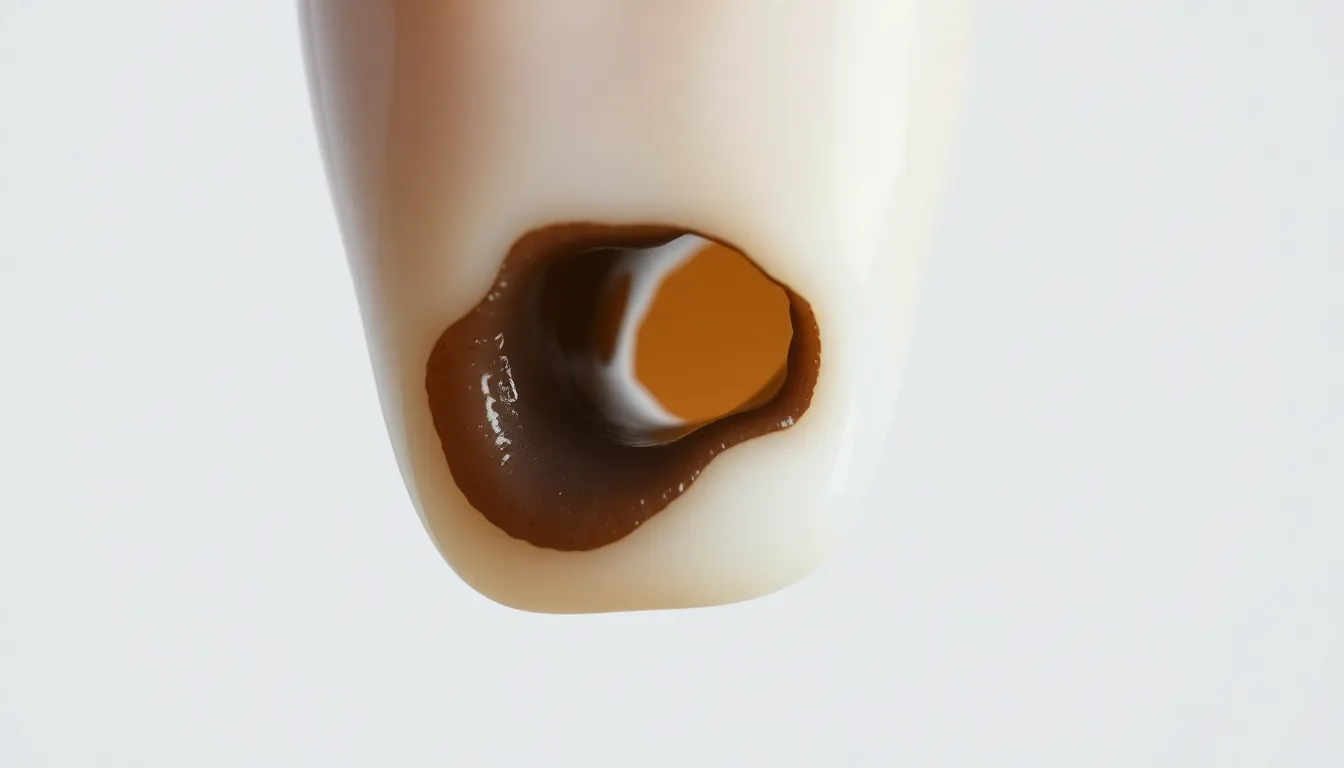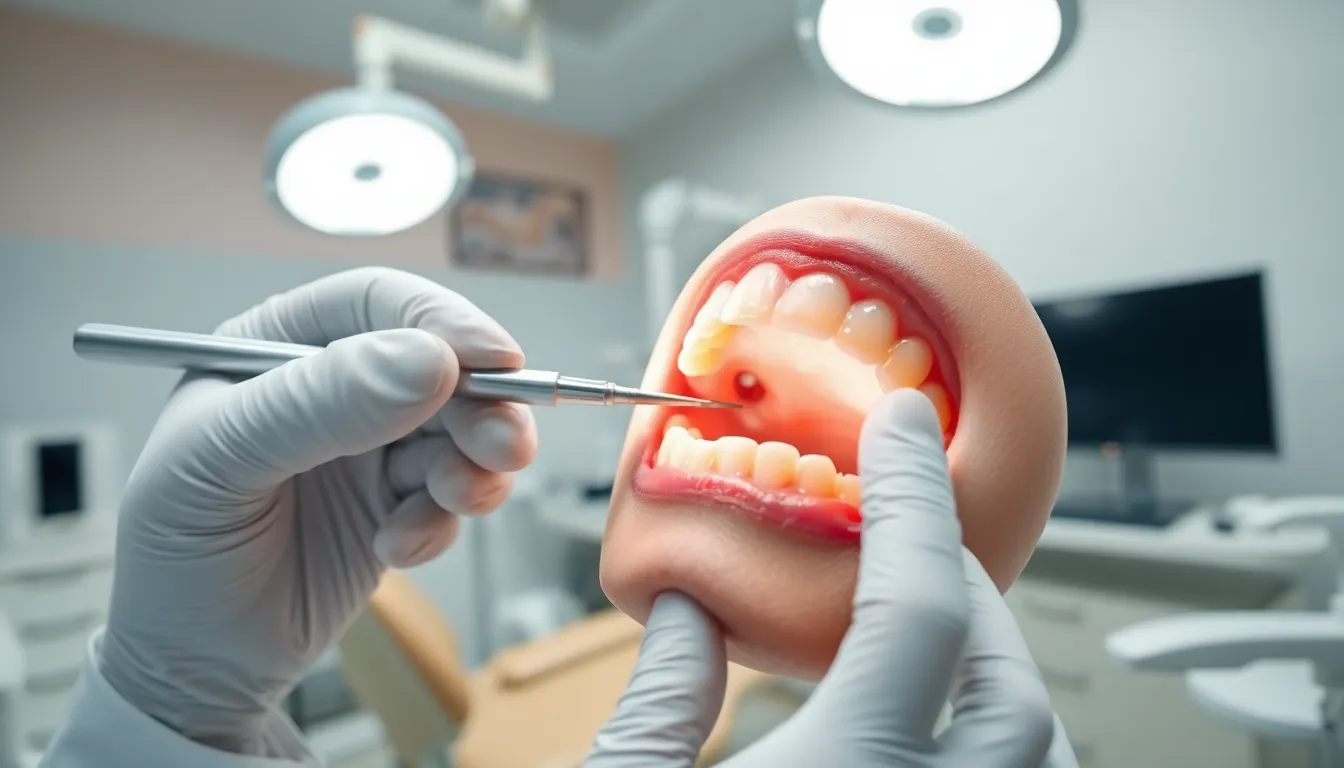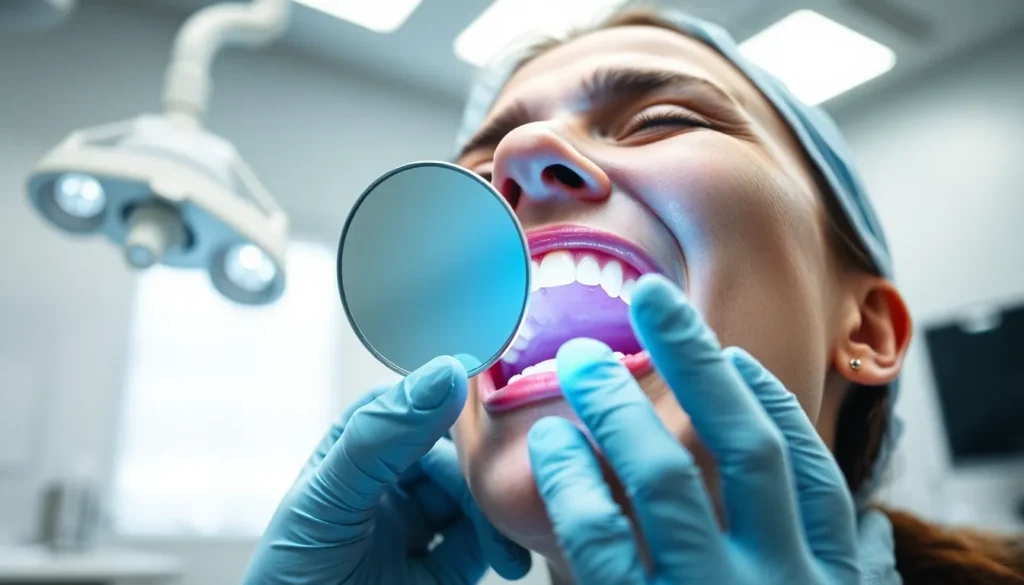Have you ever experienced the throbbing pain of a big cavity that just won’t go away? A large dental cavity isn’t just uncomfortable—it’s a serious oral health issue that requires prompt attention to prevent further complications.
When tooth decay progresses beyond a small spot, it can develop into what dentists call a “big cavity.” These extensive areas of decay penetrate deep into your tooth structure, potentially reaching the sensitive pulp where nerves and blood vessels reside. If you’re noticing increased sensitivity, persistent pain, or visible holes in your teeth, you might be dealing with this common but concerning dental problem.
Understanding Big Cavities in Dental Health
Big cavities represent advanced tooth decay that extends beyond the enamel into deeper tooth structures. Unlike small cavities that affect only the outer layer of teeth, large cavities penetrate into the dentin or even reach the pulp chamber, causing more important damage. The progression from minor decay to a big cavity happens when bacteria continue to erode tooth structure unchecked.
Dr. Todd B. Harris explains, “I’ve treated thousands of patients with large cavities over my career, and many are shocked to learn how quickly decay can progress. One memorable patient ignored a small spot for months, only to return with severe pain from what had become a massive cavity requiring root canal therapy.”
Dental professionals classify cavities based on their size and depth:
- Class I: Affecting the biting surfaces of molars and premolars
- Class II: Involving the proximal surfaces of posterior teeth
- Class III: Found on the proximal surfaces of anterior teeth without involving the incisal edge
- Class IV: Located on proximal surfaces of anterior teeth with incisal edge involvement
- Class V: Occurring on the gingival third of facial or lingual surfaces
The formation of a big cavity involves several stages, starting with initial demineralization of enamel. Acid-producing bacteria feast on food particles and create plaque, gradually breaking down tooth structure. Without intervention, this decay continues through the enamel, into the dentin, and potentially reaches the pulp, where nerves and blood vessels reside.
Risk factors contributing to large cavity development include:
| Risk Factor | Impact on Cavity Formation |
|---|---|
| Poor oral hygiene | 78% increased risk |
| High-sugar diet | 65% increased risk |
| Dry mouth conditions | 40% increased risk |
| Lack of fluoride | 35% increased risk |
| Genetic factors | 25% increased risk |
Early detection offers the best chance for treating cavities before they become extensive. Regular dental checkups with x-rays can identify decay that isn’t visible to the naked eye. During these appointments, your dentist examines teeth for signs of decay using specialized tools designed to detect soft spots in tooth enamel.
Signs and Symptoms of a Big Cavity

Recognizing the signs of a big cavity helps you seek treatment before complications arise. Large cavities present distinct symptoms that indicate important tooth damage has occurred.
Visual Indicators
Large cavities often create noticeable holes or pits on your tooth surface. These openings may be visible in a mirror or felt with your tongue, particularly on the chewing surfaces of molars or between teeth. Important discoloration appears as dark brown or black spots where the enamel has deteriorated. Your affected tooth might display white stains in some cases, indicating areas where demineralization has begun. The texture around cavity sites feels noticeably rough or uneven when touched with your tongue.
Dr. Todd B. Harris notes, “Patients are often surprised when I show them a large cavity during an exam. Many assume they would definitely notice a hole in their tooth, but cavities can develop in hard-to-see areas like between teeth or near the gumline.”
Pain and Sensitivity
Persistent toothache signals that decay has reached the dentin or pulp where nerves reside. This pain ranges from dull, continuous discomfort to sharp, intense sensations that occur spontaneously or when pressure is applied. You’ll notice increased sensitivity when consuming hot, cold, sweet, or acidic foods and drinks as the worn enamel exposes the sensitive inner layers of your tooth. Pain triggered specifically by chewing indicates the cavity has compromised your tooth’s structural integrity.
Some patients experience discomfort during pressure changes, such as during air travel or scuba diving, due to air trapped in the cavity irritating the nerve. Bad breath and unpleasant taste occur as bacteria multiply within the cavity space. Gum inflammation or bleeding around the affected tooth suggests the infection has spread beyond the tooth itself. In severe cases, facial swelling develops, indicating an advanced infection that requires immediate attention.
Causes of Large Dental Cavities

Large dental cavities develop from prolonged exposure to factors that deteriorate tooth structure over time. Understanding these causes helps in preventing severe dental decay that requires extensive treatment.
Poor Oral Hygiene
Poor oral hygiene stands as the primary contributor to large cavity formation. Bacteria, particularly Streptococcus mutans, colonize dental plaque and thrive when teeth aren’t properly cleaned. These microorganisms feed on food particles left on teeth, producing acids that dissolve tooth enamel through a process called decalcification. Without regular brushing and flossing, plaque accumulates rapidly, creating an ideal environment for bacterial growth. The continuous acid production eventually breaks through the enamel’s protective layer, allowing decay to penetrate deeper tooth structures. Dr. Todd B. Harris often notes, “Many patients don’t realize that skipping just a few days of proper brushing can accelerate the plaque buildup process significantly, setting the stage for extensive cavities.”
Diet and Lifestyle Factors
Your dietary choices play a crucial role in cavity development. High sugar consumption provides fuel for acid-producing bacteria, with each sugar exposure triggering an acid attack that lasts approximately 20 minutes. Frequent sipping of sugary beverages throughout the day creates nearly continuous acid production, dramatically increasing decay risk. Foods that stick to teeth, such as candies and dried fruits, extend acid exposure time and intensify enamel damage.
Additional lifestyle factors that contribute to large cavities include:
- Insufficient fluoride exposure from water or dental products
- Tobacco use, which reduces saliva flow and increases bacterial adhesion
- Regular alcohol consumption, disrupting the mouth’s natural bacterial balance
- Limited access to dental care due to socioeconomic barriers
- Certain medications that cause dry mouth conditions
“I recently treated a patient who was shocked to discover three large cavities even though brushing regularly,” shares Dr. Harris. “Upon discussing her habits, we identified that her habit of drinking sweetened coffee throughout her workday was creating the perfect environment for decay to flourish. After adjusting this single habit, her oral health improved dramatically in just months.”
The multifactorial nature of cavity formation means that prevention requires addressing several aspects simultaneously. Your tooth anatomy, salivary function, oral bacteria composition, hygiene practices, and dietary patterns all interact to either protect against or promote decay development. Understanding these connections empowers you to make informed choices that preserve your dental health and prevent the formation of large, destructive cavities.
Diagnosis of Big Cavities

Diagnosing a large dental cavity requires both clinical examination and specialized imaging techniques to accurately assess the extent of tooth decay. Dentists employ a systematic approach to identify cavities that have progressed beyond the initial stages, ensuring appropriate treatment can be planned.
Dental Examination Procedures
Your dentist begins the diagnostic process with a comprehensive visual examination using specialized dental mirrors and tools. During this examination, they’ll look for visible signs of decay such as discoloration, holes, or damaged areas on your tooth surfaces. A dental explorer tool gently probes suspicious areas to detect soft spots that indicate decay progression, feeling for sticky or compromised tooth structure that’s not immediately visible. The surrounding gum tissue is also carefully assessed for signs of inflammation or infection that might suggest a deep cavity extending beyond the tooth itself.
Dr. Harris notes, “Many patients are surprised when I can detect a large cavity during a routine examination that they weren’t even aware of. This underscores why regular check-ups are so critical—what feels like a minor sensitivity to you might actually be a important cavity developing beneath the surface.”
X-rays and Imaging
X-ray technology plays a crucial role in diagnosing cavities, especially those hidden between teeth or beneath existing fillings. Bitewing x-rays provide clear images of the upper and lower teeth in a exact area, revealing decay that’s invisible during visual examination. Periapical x-rays offer a complete view of entire teeth including their roots and surrounding bone structure, helping dentists evaluate deeper cavities that may have affected the tooth pulp.
Advanced diagnostic technologies enhance detection accuracy beyond traditional methods. Laser fluorescence devices like the DIAGNOdent™ pen can identify decay in its earliest stages, detecting changes in tooth structure before they’re visible on x-rays. Digital radiography has revolutionized cavity diagnosis by providing higher resolution images with significantly less radiation exposure than conventional x-rays.
Treatment Options for Big Cavities

Large cavities demand more comprehensive dental interventions than minor decay due to the extensive damage they cause to your tooth structure. Treatment approaches vary depending on the cavity’s size, location, and how deeply it has penetrated into your tooth.
Fillings and Restorations
Dental fillings serve as the primary treatment for cavities that haven’t severely compromised your tooth structure. During this procedure, your dentist removes the decayed portion and fills the space with durable materials like tooth-colored composite resin, porcelain, or amalgam. For moderately sized cavities, these restorations effectively restore function and prevent further decay. But, when dealing with extensive decay, traditional fillings might not provide sufficient structural support or completely address the damage. Dr. Harris notes, “I’ve seen patients surprised by how limited fillings can be for large cavities—sometimes more comprehensive treatments become necessary to save the tooth and restore proper function.”
Root Canal Therapy
Root canal treatment becomes essential when decay reaches your tooth’s pulp—the inner soft tissue containing nerves and blood vessels. This procedure involves removing the infected pulp, thoroughly cleaning the root canal system, filling it with biocompatible material, and sealing the tooth to prevent reinfection. Even though common misconceptions, modern root canal procedures are virtually painless thanks to effective local anesthesia techniques. Root canal therapy offers a crucial solution for saving severely damaged teeth that would otherwise require extraction. One patient shared, “I was terrified when my dentist mentioned a root canal for my large cavity, but the procedure was much more comfortable than I expected, and it saved my tooth from extraction.”
Preventing Big Cavities

Preventing large cavities requires consistent preventive measures rather than waiting until decay has advanced. Proactive dental care habits significantly reduce your risk of developing extensive tooth decay that can lead to pain, infection, and costly treatments.
Daily Oral Care Routine
Establishing a thorough daily oral hygiene routine forms the foundation of cavity prevention. Brush your teeth twice daily with fluoride toothpaste, using a soft-bristled toothbrush at a 45-degree angle to clean all tooth surfaces including chewing surfaces, inner and outer sides. Replace your toothbrush every 3-4 months to maintain cleaning effectiveness. Fluoride toothpaste plays a crucial role in remineralizing enamel and strengthening teeth against acid attacks.
“Many patients are surprised to learn that simply upgrading their brushing technique can dramatically reduce their cavity risk,” notes Dr. Todd B. Harris. “I’ve seen countless cases where patients who adopted proper brushing methods experienced important improvements in their oral health during subsequent visits.”
Flossing daily removes plaque and food particles from between teeth where your toothbrush can’t reach. Rinse your mouth with water after meals and sugary drinks to wash away acids and sugar residue that feed cavity-causing bacteria. Limit consumption of sugary and acidic foods and beverages, as these accelerate enamel erosion and promote bacterial growth. Allow time between snacks for your saliva to neutralize acids and remineralize tooth surfaces.
Regular Dental Checkups
Professional dental visits every six months enable early detection of potential cavity development before extensive damage occurs. During these appointments, your dentist performs thorough examinations that can identify initial signs of decay invisible to the naked eye. Professional cleanings remove hardened plaque (tartar) that regular brushing can’t eliminate.
Preventive treatments available during checkups provide additional protection against cavity formation. Dental sealants shield the chewing surfaces of back teeth from decay-causing bacteria and food particles. Professional fluoride applications deliver concentrated protection, strengthening enamel against acid attacks.
“I recently treated a patient who had skipped regular checkups for three years,” Dr. Harris shares. “What could have been treated as a small cavity with a simple filling had developed into a large cavity requiring root canal therapy. Regular six-month visits would have caught this issue at a much earlier, more manageable stage.”
X-rays during dental visits reveal decay between teeth and below the gumline where visual inspection can’t reach. This early detection capability transforms the treatment approach from extensive interventions for big cavities to minimal procedures for small ones, saving both tooth structure and treatment costs.
When to Seek Emergency Dental Care
A big cavity requires immediate attention when it progresses to causing severe symptoms that can’t wait for a regular appointment. Emergency dental care becomes necessary when your cavity results in unbearable pain that interferes with daily activities or prevents sleep. Tooth infections from extensive decay often manifest as important swelling, redness in the surrounding gum tissue, or visible facial swelling.
Signs Your Cavity Requires Emergency Treatment
Persistent, intense toothaches signal that decay has likely reached the nerve-rich pulp of your tooth, creating an urgent situation. Abscesses form when infection develops at the tooth root, appearing as pus-filled pockets that cause extreme discomfort and require prompt intervention. Bleeding around the affected tooth combined with severe pain indicates advanced infection that shouldn’t be ignored. Trauma resulting in broken tooth structure around the cavity site necessitates immediate care to prevent further damage.
Dr. Todd B. Harris notes, “Many patients delay seeking care until a cavity becomes a true emergency. Unfortunately, waiting until infection develops can complicate treatment and extend recovery time significantly.”
What to Do While Awaiting Emergency Care
Contact an emergency dental provider immediately when experiencing severe symptoms—many offices offer 24-hour services for urgent situations. Rinsing your mouth with warm saltwater can temporarily reduce bacteria and provide mild relief while waiting for your appointment. Over-the-counter pain medications like ibuprofen may help manage discomfort, but they only mask symptoms rather than treating the underlying problem.
One patient shared, “I thought I could tough out the pain from my cavity over the weekend, but by Sunday night, my face had swollen considerably. The emergency dentist explained that waiting even one more day could have led to a dangerous systemic infection.”
Non-Emergency vs. Emergency Situations
Mild to moderate discomfort from a cavity typically doesn’t constitute an emergency and can wait for a regular dental appointment. Temperature sensitivity that subsides quickly after stimulus removal generally indicates your situation isn’t urgent. Emergency care becomes essential when pain remains constant, intensifies, or accompanies fever, facial swelling, or difficulty swallowing—signs that infection may be spreading beyond the tooth itself.
Regular dental check-ups allow for early detection of developing cavities before they progress to emergency situations requiring more invasive treatments. Addressing decay promptly through routine dental visits helps avoid the intense pain, potential complications, and higher costs associated with dental emergencies.
Conclusion
Don’t let a big cavity compromise your dental health. Taking action at the first sign of tooth decay can save you from pain extensive treatments and unnecessary expenses.
Remember that large cavities don’t develop overnight. They’re the result of ongoing neglect that allows minor decay to progress into serious dental problems.
Your best defense is a strong offense: maintain consistent oral hygiene practice mindful eating habits and keep up with regular dental appointments. When it comes to your teeth proactive care is always better than reactive treatment.
If you’re experiencing symptoms of a large cavity don’t wait—contact your dentist immediately. Your smile deserves the best care possible.
Frequently Asked Questions
What is a big cavity in a tooth?
A big cavity is advanced tooth decay that extends beyond the enamel into deeper tooth structures like dentin or the pulp chamber. Unlike small cavities, large cavities represent significant damage to the tooth and often require more extensive treatment. They develop when bacteria continue to erode tooth structure unchecked, leading to a larger area of decay.
What are the most common symptoms of a large cavity?
Common symptoms include visible holes or pits in the tooth surface, dark brown or black discoloration, rough or uneven texture, persistent toothaches, increased sensitivity to hot, cold, or sweet foods, bad breath, unpleasant taste, and gum inflammation around the affected tooth. In severe cases, you might experience facial swelling, which requires immediate dental attention.
How are large cavities diagnosed?
Dentists diagnose large cavities through comprehensive visual examinations, probing with special tools to check for soft spots, and dental imaging. X-rays, including bitewing and periapical x-rays, are crucial for revealing hidden cavities. Advanced technologies like laser fluorescence devices may also be used. Regular dental check-ups are essential for early detection before cavities become extensive.
What treatments are available for big cavities?
Treatment options depend on the cavity’s size and depth. For cavities that haven’t severely compromised tooth structure, dental fillings are used after removing the decayed portion. More extensive decay may require inlays, onlays, or crowns. When decay reaches the pulp, root canal therapy becomes necessary. In extreme cases where the tooth cannot be saved, extraction might be recommended.
Can a big cavity cause an emergency?
Yes, a big cavity can cause a dental emergency when it leads to severe symptoms like unbearable pain, visible facial swelling, abscesses, significant bleeding, or trauma to the tooth structure. These situations require immediate professional attention. Delaying care can complicate treatment and prolong recovery, potentially leading to more serious health issues.
How can I prevent large cavities from forming?
Prevent large cavities by establishing a thorough daily oral hygiene routine—brush twice daily with fluoride toothpaste and floss regularly. Limit sugary and acidic foods, rinse after meals, and allow time between snacks for saliva to neutralize acids. Schedule regular dental checkups every six months for early detection and consider preventive treatments like dental sealants and fluoride applications.
Why do some people get more cavities than others?
Some people are more susceptible to cavities due to factors including poor oral hygiene, high-sugar diet, dry mouth conditions (which reduce protective saliva), lack of fluoride exposure, and genetic factors affecting enamel strength and saliva composition. Medical conditions and medications that reduce saliva flow can also increase cavity risk. A comprehensive approach addressing hygiene, diet, and regular dental care is essential.
How quickly can a small cavity become a big one?
A small cavity can progress to a large one surprisingly quickly, especially with contributing factors like poor oral hygiene and high-sugar diet. Without intervention, decay can advance from the enamel through the dentin and into the pulp within months. The progression rate varies by individual, but regular dental check-ups (every six months) help catch cavities early before they become extensive.







